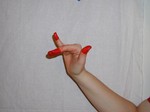Vardhamāna
Saṃyuta Hasta - Double Hand Gestures
Descriptions and Meanings
9:152
This is the combination of the Mukula hand and Kapittha in close clasp,
9:153:
If one hand is pressed with the other this hand indicates grasping, receiving, preserving, convention, truthfulness and compression.
9:154
The combination of two Hamsapaksa hands turned down is also known as Vardhamāna.
9:154:
It is utilized in represent-ing the opening of objects like latticed windows.
9:131
Two Haṃsapakṣa hands turned down will be the known as the Vardhamāna
9:131:
It is to be used to represent the opening of objects like latticed windows.
26:68
When two Haṁsapaksha hands are in the opposite directions, the combination is Vardhamana.
26:69:
The acting should be done to show lattice (Jala) windows, etc.
No verse annotation
Vardhamāna (increase): Hamsa-paksa hands palms down, turned together face upwards. Patron deity Vasuki.
No verse annotation:
Narasimha, his glory, tearing the raksasa’s chest.

Haṁsapaksha - No verse annotation

Haṁsapaksha - No verse annotation
Not included elsewhere
8:526-527
When two Hamsapaksha hastas are held, palms down and then turned together, face upwards, then it becomes Vardhamāna hasta. Its presiding deity is Vasuki.
8:526-527:
This hasta is used to denote Nrsimha, His glory / radiance, tearing apart the demon's (Hiranyakasipu's) chest.
8:584-585
When two Sikhara hastas are held pointing upwards, then it is Vardhamāna hasta.
8:584-585:
This hasta denotes saying - always, it is given, what-what? and once upon a time.
4:1236-1237
Vardhamāna: The hands which are in the Mrgasirsa Hasta are crossed.
4:1236-1237:
This Hasta is used to depict opening doors, windows and the like,
7:69
Vardvmāna: With the kapittha hands if the mukula hasta is tried to form, it is vardhamāna
7:69:
It shows collection, brevity and satya vākyam (veracity).
2:190
When the haṁsapaksha hastas are turned away from each other, it is the vardhamāna hasta. .
2:190:
If separated from a crossed position it can depict doors and opening windows.
2:191:
When moved apart from proximity, it shows tearing the enemy’s chest, etc. other scholars opine that this hasta is to be held with sarpasirsa.
:67
If two Mrgasirsa hastas are put together at the front, it is called Vardhamana hasta by Subharikara.
:757:
A netted window, etc., a town, a city (with large buildings), finding out lice, etc., rending of the heart of an enemy
:758:
tearing off of clothes, a door, taking up, union, contraction, regulation, truth, washing of clothes—the hasta Vardhamana is indicated in these.
:759
Vardhamana, with its tip pointing up,
:759:
is applied to mean a netted window. It represents a town. It stands for a city.
Not included elsewhere
:760
If Vardhamana moves from the front to the back,
:760:
it means trying to find out lice, etc. ||
Not included elsewhere
:761
If the two hands of Vardhamana are moved from the front to the two sides,
:761:
it denotes the tearing off of clothes. It indicates a door.
Not included elsewhere
:761
If Vardhamana is taken round and put in the lap,
:761:
it means taking up.
Not included elsewhere
:761
If the two hands of Vardhamana are firmly brought together,
:761:
it means union.
Not included elsewhere
:762
If Vardhamana is held facing up at the front,
:762:
it means contraction.
Not included elsewhere
:762
Vardhamana, lying across at the front,
:762:
means regulation.
Not included elsewhere
:762
Vardhamana, hanging at the front,
:762:
denotes truth.
Not included elsewhere
:762
If Vardhamana is brought down from on high,
:762:
it indicates the washing of clothes.
Not included elsewhere
7:109
If two haṁsapakṣa-hastas, facing away from each other, are [crossed] like a svastika, it is vardhamāna.
Not included elsewhere
3:459-460
When two haṁsapakṣa hands are crossed in svastika turned in opposite directions, it is known as vardhamāna. This can be done in three ways, either with mrgasirsa or [with] sarpasirsa [but moved in] the same way.
3:459-460:
It is used in opening a door or a window. When [these] haṁsapakṣa hands are separated from svastika, they indicate beating the chest. Others say that it is the second kind of nisadha.
![That [gesture] is known sarpasira when the palm of the patāka hand is curved in the middle.](https://lakshmiammanswebsite-live-00aaba1203334-2b2b45f.divio-media.com/filer_public_thumbnails/filer_public/c6/b6/c6b6321b-86b1-4a66-83eb-acd167b81d8b/img_8039.jpeg__150x150_q90_subsampling-2.jpg)
Sarpaṡīrsha (Ahiphaṇa) - 3:397

Mṛgašīrsha - 3:404-405
![[ When] three fingers of patāka hand starting with the forefinger are bent in a similar way and the little finger is extended, then [it] is known as hamsapaksa.](https://lakshmiammanswebsite-live-00aaba1203334-2b2b45f.divio-media.com/filer_public_thumbnails/filer_public/11/71/11710444-d29e-4007-94f7-e393f9eb640c/hamsapaksa.jpg__150x150_q90_subsampling-2.jpg)
Haṁsapaksha - 3:408-409
Not included elsewhere



 Svastika
Svastika

